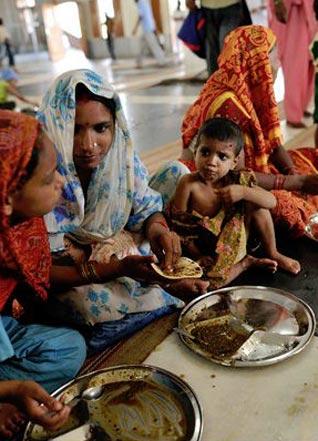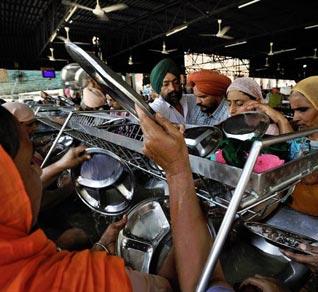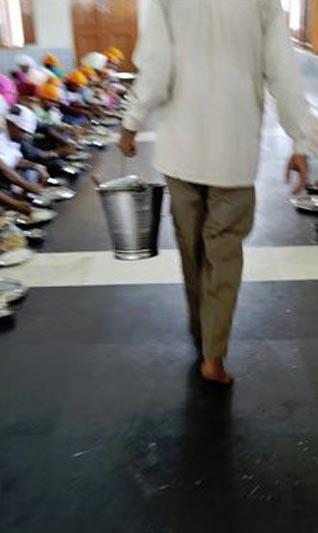Travel
The Golden Temple of Amritsar:
Food For The Body & The Soul
by MATT WADE
He cooks lentils in a pot the size of a plunge pool. Jitendra Singh's soupy concoctions help feed tens of thousands of people each day at the Golden Temple, the holiest shrine of the Sikh religion.
The glimmering gurdwara is one of India's best-known religious monuments but its kitchen is also something to behold.
''This is the biggest free eatery in the world,'' says Jitendra Singh, as he stokes the wood fire beneath his bubbling pot that holds 500 kilograms of grain and takes 11 men to lift.
It is hard to dispute his claim. On weekdays the Golden Temple's canteen, called the langar, provides meals for about 80,000 people. On weekends and festival days twice that number may turn up.
What makes the langar even more remarkable is that the food is prepared and distributed mostly by unpaid helpers.
The kitchen manager, Raghbir Singh, says more than 1000 volunteers usually come. ''We encourage everyone to do service here, and anyone can join in. Many of those who help have prestigious jobs.''
Not far from where Jitendra tends his mammoth vessel, bearded men in saffron turbans lug sacks of wheat to supply a team of women rolling chapattis, the flat bread favoured in northern India. Near them, 100 people wash up in long sinks amid the crash of steel plates. An enormous drying rack stores an estimated 40,000 plates, bowls and spoons.
Meals are served in two dining rooms that rotate about 700 people at a time. There is no furniture. Visitors sit on the floor and are served a vegetarian meal of lentils, rice, vegetables, chapatti and a milky sweet. Chai is also offered.
At the end of each sitting, cleaning teams move in to sweep and swab the smooth concrete floors.
''Nobody will go hungry here,'' Raghbir says. ''Anyone can come and find a meal 24 hours a day.''
It has been that way since the 16th century, when the gurdwara's free kitchen was founded by the Third Sikh Guru, Amar Das.
The Golden Temple is a spiritual sanctuary in the heart of Amritsar, a city close to the Pakistan border in the subcontinent's northern Punjab province.
Locals call the radiant shrine the Harmandar Sahib - the abode of God. Its dome is said to be gilded with 750 kilograms of pure gold. Many visitors prostrate themselves in reverence in front of the temple and bathe in its pool.
Minstrels inside the temple maintain a continuous singing of hymns from the Sikh scripture kept there. This is amplified around the vast complex, adding to the sacred atmosphere.
The Sikh religion, which emerged in the Punjab region about 500 years ago, rejects - inter alia - the social hierarchies of caste, which is a fundamental precept of Hinduism.
The principle of equality is enshrined in the langar, where everyone eats together sitting on the floor, regardless of social status.
The army of volunteers is testament to another key tenet of the Sikh faith. Says Dalbir Singh, the gurdwara's information officer: ''There can be no worship without good actions.''
Volunteers from all walks of life help prepare food and clean up. Some arrive at 4 am and stay until late in the evening.
As he chops ginger over a steel pot, Gurchand Singh, a retired military man, says: ''Sikh scriptures tell us that a person will enjoy the fruits of life when doing service.'' He and several friends work at the langar five or six times a week.
Mukhwinder Kaur, 30, sits with a team of vegetable cutters surrounded by garlic skins. ''I used to come with my mother so I have lived this service since childhood,'' she says. ''But I am still very content doing it.''
Bhuinderjit Singh, a commercial pilot, cuts onions beside a man wearing a pair of industrial goggles so his eyes do not sting. ''I experience God doing this,'' Bhuinderjit says.
There has been deadly tension between Sikhs and India's government [- which is heavily influenced by right-wing and fundamentalist Hindus - over the latter's human rights violations], but people from all religions are welcome to eat, and serve, at the langar.
Sanjkta, a Hindu from the distant province of West Bengal, sits peeling garlic with a group of local women. ''Yesterday I came here to eat with my family but today I have come to offer service,'' she says.
Many pilgrims visiting the Golden Temple - of all faiths and backgrounds - consider a meal at the langar a spiritual blessing.
Sonu Pandey, a Hindu from the neighbouring state of Haryana, emerges beaming from the dining hall. ''This is a very special meal,'' she says. ''It's is not just food; it is something offered to God.''
Baramki, who visited the temple with a busload of 50 Hindu pilgrims from the state of Uttar Pradesh, described eating at the langar as ''parshad'', a term meaning something edible offered to God.
Like the labour, much of the food used at the langar is donated.
Volunteers also help keep the temple complex clean. Twice a day, the wide marble walkway around the perimeter is scrubbed by scores of unpaid workers who scoop buckets of water from its pool, then sweep, swab and mop.
All visitors must remove their shoes before entering the temple, so volunteers run a footwear-minding service at each entrance. This provides another opportunity for voluntary service: after 6 pm leather shoes left by forgetful visitors are polished free.
[Courtesy: The Sydney Morning Herald]
January 22, 2011
Conversation about this article
1: Mohan Singh (Toronot, Ontario, Canada), January 22, 2011, 6:49 PM.
This is the temple of the ONE GOD and not gold. That is why we call it Darbar Sahib or Harmandar Sahib.
2: Sangat Singh (Kuala Lumpur, Malaysia), January 22, 2011, 6:53 PM.
The 'Wadda' Gurdwara in Lyallpur was also a playground for us kids to play hide-and-seek during school holidays. One day after a vigorous game, the ring leader announced that we shall all have langar that we immensely enjoyed. Back home, I proudly announced that we had langar today and was instantly rewarded with a tight slap, followed by a lesson. "Guru ka Langar" was for the needy and the pilgrims from out-station and not for you whose house was just 100 yards away. You and your gang will now have to do seva for one week in the Langar hall!". Also we were told the meaning of words in the ardaas that we repeated daily: "Utter Waheguru ... and those who worshipped the Naam. And shared their food with others!"
3: Pali Kaur (San Jose, California, U.S.A.), January 24, 2011, 8:27 PM.
This is better then the NY Times article that only interviewed Hindus and unfortunately did a horrible job explaining what Sikhism is.






